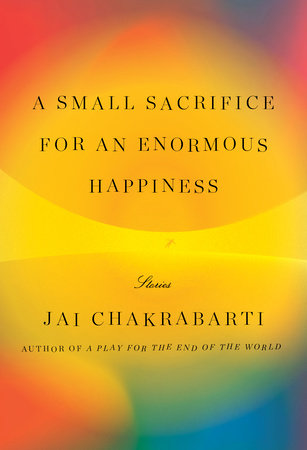A Small Sacrifice for an Enormous Happiness Reader’s Guide
By Jai Chakrabarti


1. What does the title of the book suggest about how characters approach questions of love and belonging? Are there characters whose sacrifices truly move them toward a greater happiness? How do you relate to this idea in your own life, a sacrifice for the sake of love?
2. The titular story explores the role of class in relationships as well as the boundaries cultural traditions impose. How do you think Nikhil navigates his own privilege as he strives for a deeper intimacy with Sharma? While this story was set in 1980 and in Kolkata, India, are there elements that you connect with in your present moment?
3. In “Lilavati’s Fire,” Harish and Aparna are longtime partners who lack a deeper intimacy. How do Aparna’s attempts at creating a novel invention heighten or further risk their relationship? How have you observed romantic partners “crying out” for attention, and where have these efforts taken them?
4. The collection wrestles with a yearning for desiring children, though when children appear and even grow up, as in “Lilavati’s Fire,” the yearning is often replaced by an illumination, sometimes even disappointment. What role does wanting children play in these stories, and how does the reality of children alter the relationships in these stories?
5. A few stories in this collection explore the complexities of adoption. How do Harold and Shira’s views (from “Daisy Lane”) on this topic intersect or differ from the Afghani merchant known as the Kabuliwallah (from “The Fortunes of Others”)? In what ways do you see characters evolving their perspectives as the stories and situations progress?
6. “The Narrow Bridge” finds its title from a Rabbi Nachman verse, which could be translated as “The entire world is a narrow bridge; the most important thing is to not become paralyzed by fear.” How does the theme of the narrow bridge materialize throughout the collection? Are there moments in your life when you’ve found yourself connecting to this metaphor, and how have you made friends with your fear?
7. “Mendel’s Wall” is about a literal but also an emotional wall that is erected to separate a husband from his wife. Are there other “walls” that permeate in these stories, and how do these walls influence relationships?
8. “A Mother’s Work” and “Searching for Elijah” can be read together as a commentary on the ways in which orthodoxy interrupts and transforms cross-cultural relationships. What were the commonalities you found among the parents in these pieces? What were the differences?
9. In “The Import” a husband and wife in Brooklyn solicit the childcare services of a villager from India. How does Rupa view Bethany and Raj; does the way in which she views their relationship shift over time, or does she come in with a set of preconceptions about who they are that largely remain?
10. Many of the stories in this collection are about immigrants cultivating home with a chosen family. Which characters’ journeys resonated with you the most? How do you define “home” in your own life and how has that changed for you over the years?
11. The character of the Kabuliwallah in the final two stories is seen in different lights, but it’s clear that he’s a journeyman, a wanderer, who in “The Fortunes of Others” has finally found a sense of home and of family. How do you think the Kabuliwallah will respond to Hannah’s request, and is his response in some ways the greater sacrifice for someone else’s happiness?
Just for joining you’ll get personalized recommendations on your dashboard daily and features only for members.
Find Out More Join Now Sign In